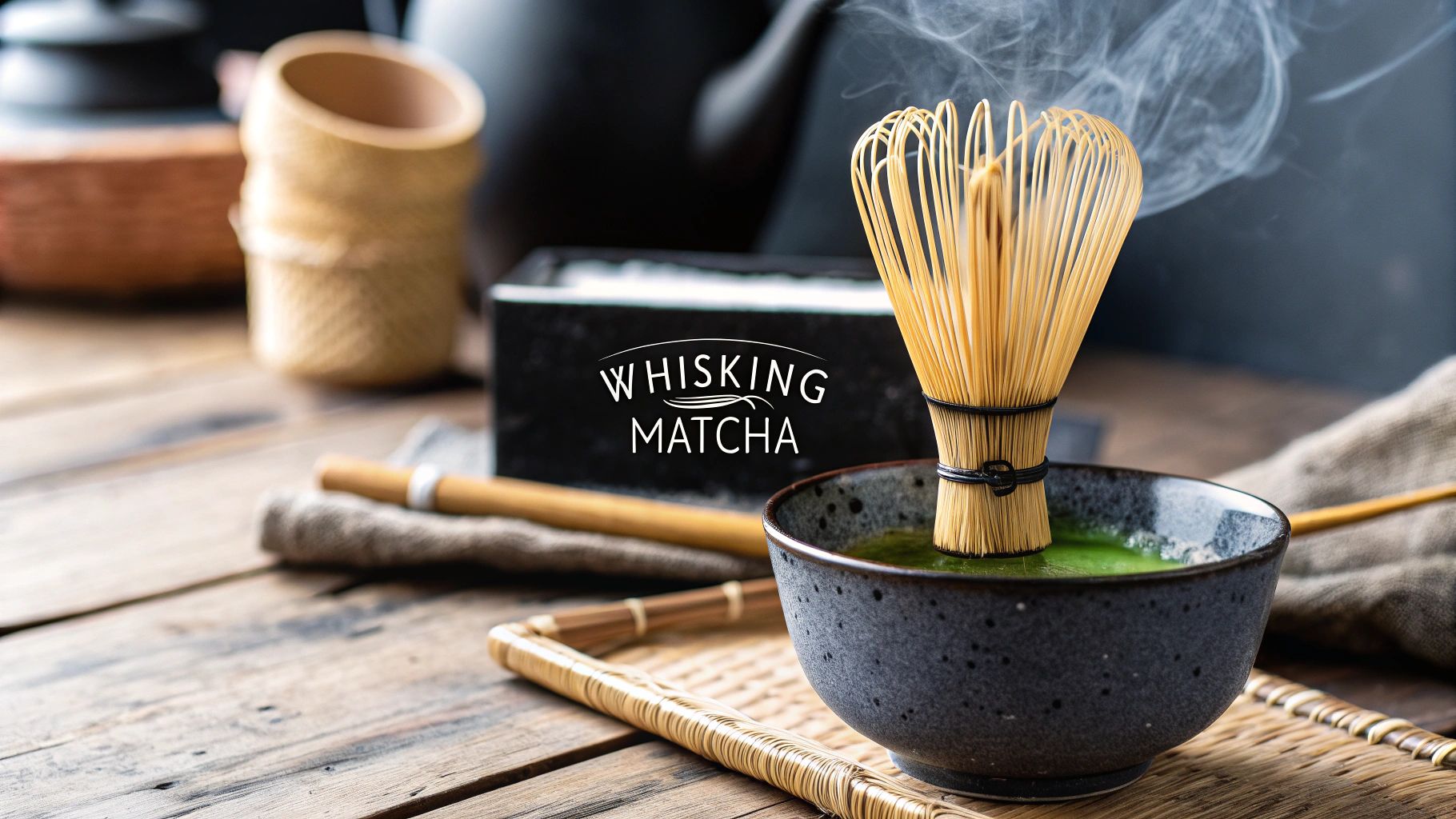The secret to a perfect bowl of matcha isn't just about high-quality powder; it's all in the whisking. A quick, sharp 'M' or 'W' motion with a bamboo whisk (chasen) is what separates a truly exceptional cup from a disappointing one. This isn't just stirring. It’s a specific technique designed to aerate the tea and suspend the fine particles, creating that smooth, frothy texture that unlocks matcha's incredible flavour.
Once you get the hang of this, you can wave goodbye to those gritty, bitter cups for good.
Why Proper Whisking Unlocks Amazing Matcha
Let's be blunt: the difference between a lumpy, harsh cup of matcha and a creamy, vibrant one boils down to a single skill—how you whisk it. We're not just talking about mixing powder and water here. The goal is to create a perfectly smooth emulsion, transforming simple ingredients into a sublime experience.
The rapid motion of the bamboo whisk achieves two crucial things. First, it breaks up any clumps and ensures every particle of the fine matcha powder is fully suspended in the water. No more gritty sediment at the bottom of your bowl. Second, it whips air into the liquid, building that beautiful, signature layer of delicate microfoam on top.
This frothy layer is non-negotiable. It does more than just look pretty; it fundamentally softens the matcha’s flavour profile, mellowing out any bitterness and letting the rich, savoury umami and subtle sweetness come forward.
Understanding this turns the act of making matcha from a simple chore into a mindful daily ritual. It’s about setting yourself up for an authentic experience and, frankly, a much tastier cup of tea.
More Than Just a Drink
Proper whisking also ensures you’re getting the full wellness benefits locked inside the leaves. Matcha is packed with antioxidants—up to 137 times more than regular brewed green tea, in fact. This incredible concentration has cemented its reputation as a genuine superfood here in the UK.
This shift towards natural wellness is more than just a passing phase. A recent survey showed that 62% of global consumers, including a large number in Britain, now actively choose natural energy sources like matcha over synthetic alternatives. When you take a moment to prepare your matcha correctly, you're not just making a drink; you're creating a moment of focused, clean energy.
If you're weighing up your morning options, it’s worth taking a look at our guide on matcha versus coffee for sustained energy. To learn more about these consumer trends, you can read the full findings on the matcha market.
Gathering Your Essential Matcha Tools
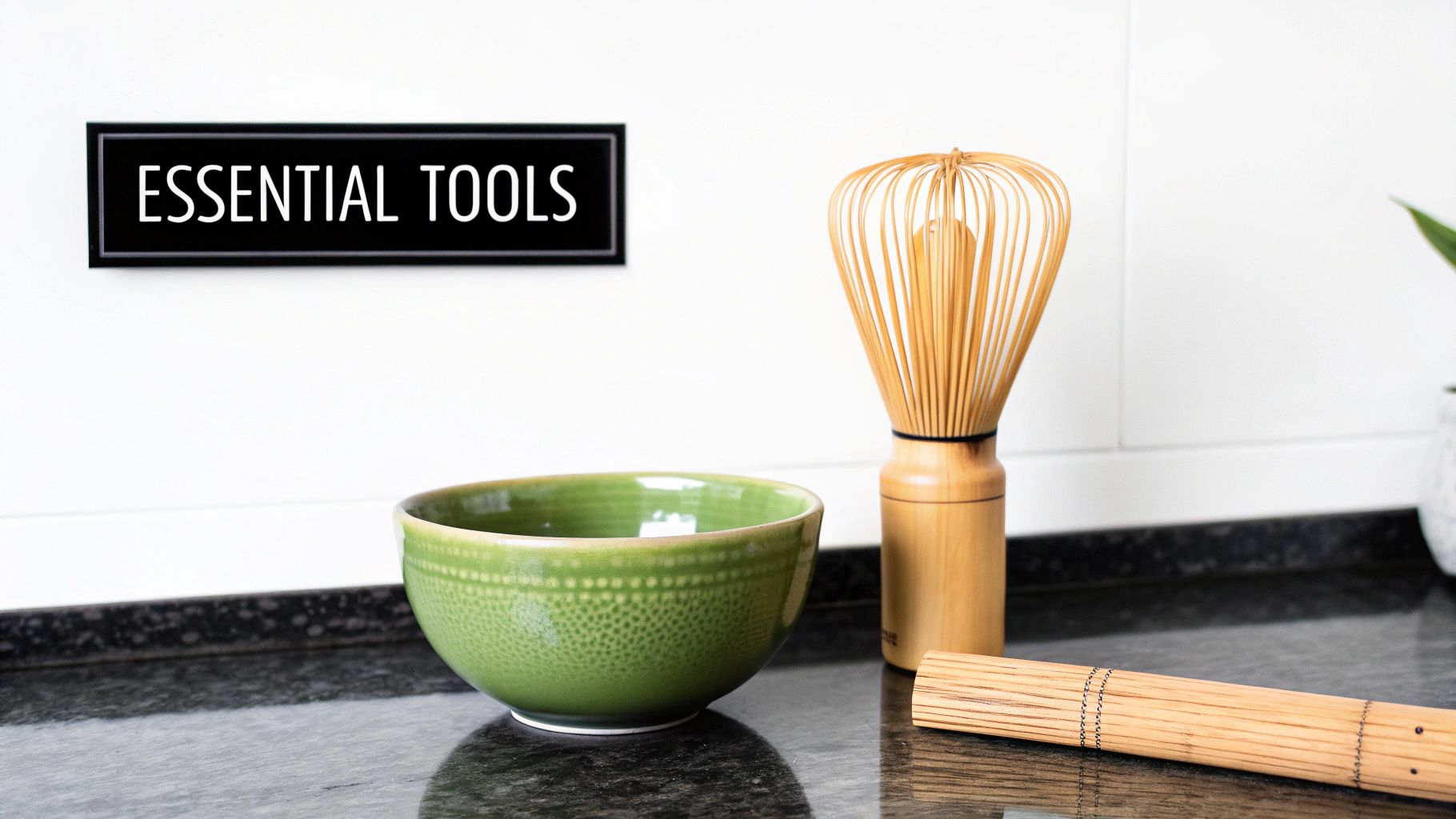
To really get the best out of your matcha, having the right equipment isn't just about tradition; it’s about making the process easier and the result a whole lot better. Each tool is designed to do one thing perfectly, working in harmony to turn that vibrant green powder into a smooth, frothy drink. Think of it like a chef's favourite set of knives—each one has a specific job.
The most iconic tool is, of course, the bamboo whisk, or chasen. Its real magic is in how it's made. Crafted from a single piece of bamboo, its 100 or so flexible tines are what whip up that signature velvety foam. A standard metal kitchen whisk is just too clumsy; it can't aerate the matcha in the same delicate way and usually leaves you with big, soapy bubbles that disappear in seconds.
The Tools of the Trade
Before you can whisk up that perfect cup, you’ll need a few key items. While you can improvise, these traditional tools have been perfected over centuries for a reason.
Here’s a quick rundown of the gear you'll want on hand. Each piece plays a specific, important part in crafting a flawless bowl of matcha.
| Tool | Traditional Name | Primary Function | Pro Tip |
|---|---|---|---|
| Matcha Bowl | Chawan | Provides a wide, flat base for effective whisking and high sides to prevent splashes. | Choose a bowl that feels comfortable to hold. The texture and weight are part of the experience! |
| Bamboo Whisk | Chasen | Aerates the matcha and water, creating a smooth consistency and a rich layer of foam. | Always soak your chasen in warm water for a minute before use to soften the tines and prevent breakage. |
| Bamboo Scoop | Chashaku | Measures the ideal amount of matcha powder (1-2 scoops) for a single serving. | A level scoop is all you need. Don't pack the powder down. |
| Fine-Mesh Sieve | Furuî | Breaks up clumps in the powder, ensuring a silky, lump-free texture in the final drink. | Sift the matcha directly into your chawan to avoid creating new clumps during transfer. |
This set of tools isn't just for show; it's a practical kit that sets you up for a consistently delicious and beautiful cup of matcha every single time.
Why Each Tool Matters
Let’s quickly touch on why you can't just grab any old bowl or spoon from your kitchen drawer.
A proper matcha bowl, the chawan, needs that wide, flat bottom. It gives you the room you need for the brisk "M" or "W" whisking motion without sloshing green tea all over your counter.
The bamboo scoop, or chashaku, isn't just for looks. It's shaped to measure the perfect serving of matcha, which is typically 1-2 grams. This helps you get a consistent flavour and strength every time you make it.
And that fine-mesh sieve? It’s absolutely essential. Matcha powder is incredibly fine and loves to clump together because of static and humidity. Sifting it is the only surefire way to get that perfectly smooth, silky texture we’re all after.
A Little Insider Advice: You don't need to break the bank on your first set of tools. But if you're going to invest in one piece, make it a good quality chasen. It truly makes the biggest difference. If you're curious about alternatives or want more tips, take a look at our guide on how to use matcha powder. In a pinch, a small electric milk frother can get the job done, but it won't give you that same authentic, high-quality foam.
Mastering the Whisking Motion: Your Path to Perfect Matcha
This is where the real art of making matcha comes alive. With your tools laid out, it's time to get hands-on and create that beautiful, frothy crown. It’s a rhythmic, fluid motion that, with a little practice, will quickly become second nature. Let's forget any intimidating, complex instructions and focus on a straightforward, natural technique.
First, let's get our proportions right. For a classic usucha (thin tea), which is the standard for daily enjoyment, you'll need about 1-2 grams of matcha. That's one or two of those lovely bamboo scoops of our ceremonial grade Amatsu Pure. Water temperature is also crucial; aim for around 80°C. Any hotter and you risk scorching the delicate tea, leaving it with a bitter taste.
This simple visual breaks down the core preparation steps to get you started.
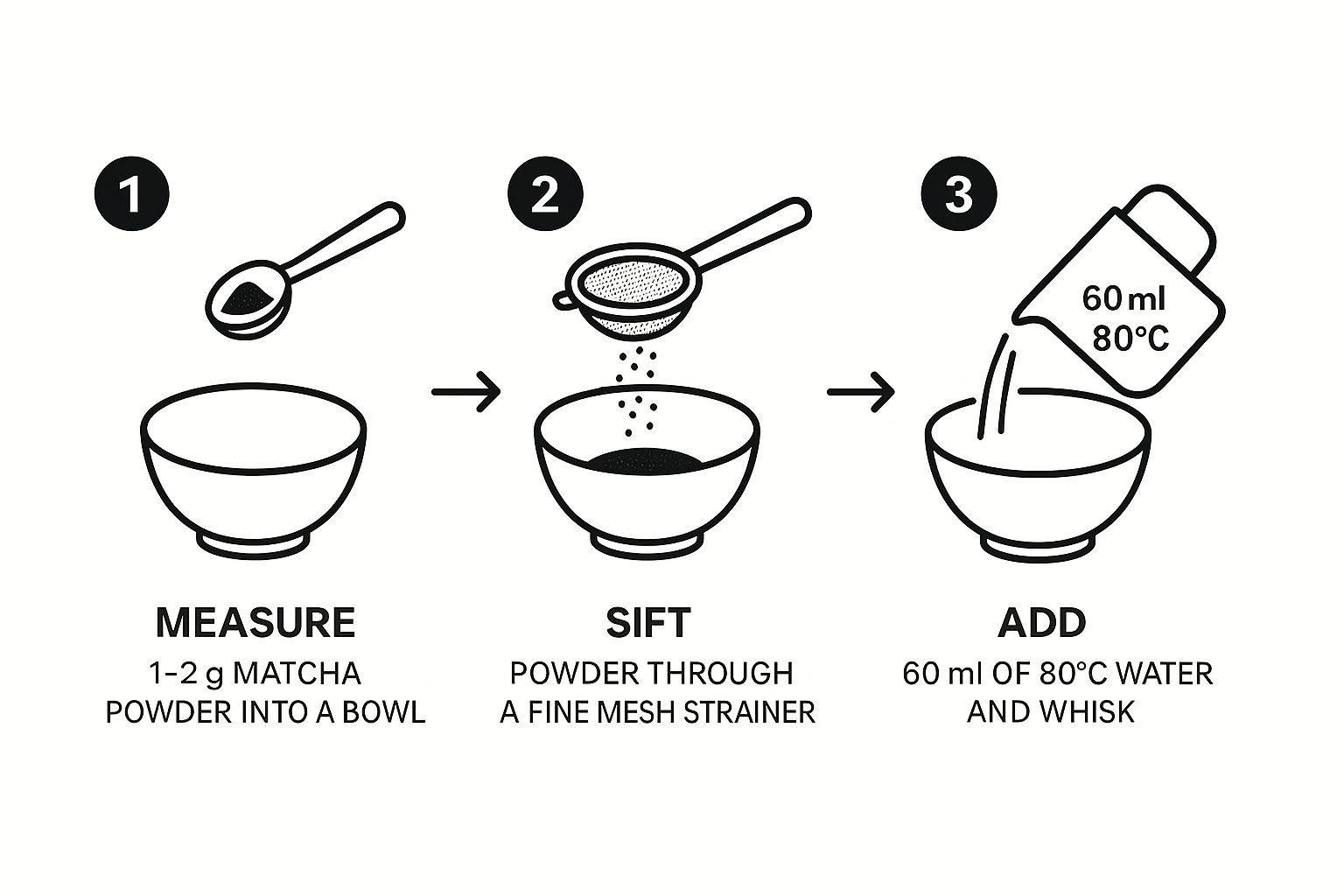
As you can see, sifting the powder before adding your hot water is a non-negotiable step. It’s the secret to a silky, clump-free drink.
The 'M' and 'W' Whisking Technique
Once your sifted matcha and perfectly heated water are in the bowl, it's time to bring out the chasen. The entire movement should come from your wrist, not your arm.
Holding the whisk vertically, begin to move it briskly back and forth across the bowl in a zig-zag pattern, almost like you're drawing a series of fast ‘M’s or ‘W’s. You want to be quick and energetic, agitating the mixture to whip air into it. Try to avoid scraping the bottom of your bowl—the goal is to froth the liquid, not grind the ceramic!
A little tip from experience: Keep your wrist loose and relaxed. If you tense up your arm, you'll tire out quickly and the froth just won't form as well. The whole energetic part of the whisking should only take about 15-20 seconds.
When you see a nice layer of tiny bubbles appear, you can slow down. For a professional finish, gently stir the surface in a circle to pop any larger bubbles, then lift the whisk straight up from the centre of the bowl. This little move leaves you with a beautifully smooth and velvety microfoam.
This entire process is a key part of the matcha ritual. For a more detailed walkthrough, including how to adapt this for lattes and other creations, have a look at our complete guide on how to make matcha. Following these steps is your ticket to a consistently smooth, frothy, and delicious cup every single time.
Tackling Common Matcha Problems
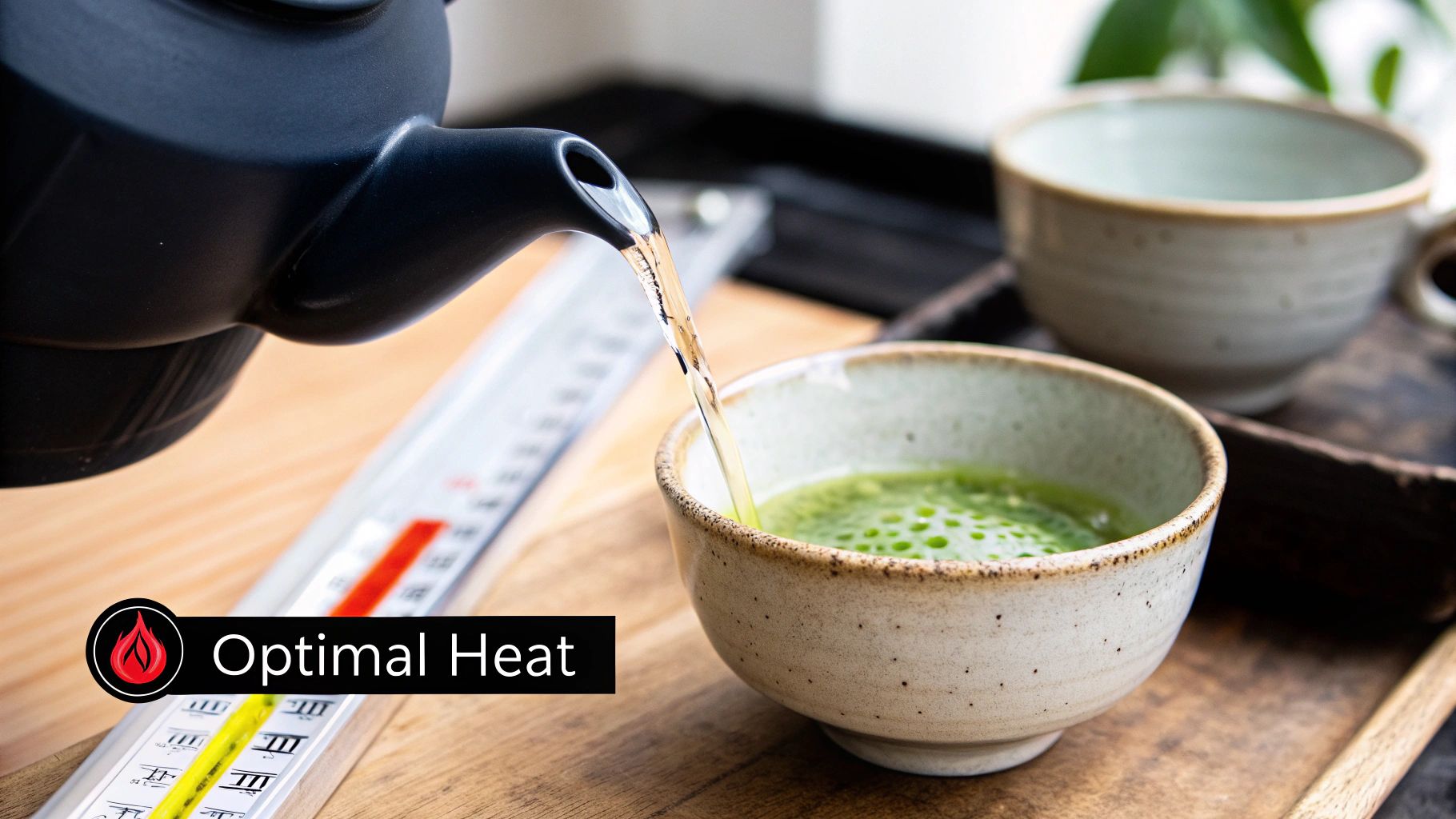
Even with the best intentions, your first few attempts at whisking matcha might not turn out perfectly. It can be frustrating to end up with a lumpy, bitter, or foam-less cup. But don't worry, you're not alone. These are common hurdles for newcomers, and thankfully, they're usually easy to fix once you pinpoint the cause.
Let's walk through the most frequent issues. Think of this as your personal troubleshooting guide to help you refine your technique and finally get that delicious, vibrant bowl you've been aiming for.
Why Is My Matcha Not Frothy?
That beautiful, creamy microfoam is the hallmark of a well-prepared matcha. If your bowl is looking a bit flat, it usually comes down to one of three things.
- Your Whisking Motion: The secret is in the wrist. A lazy stir won't cut it. You need a quick, zig-zag 'M' or 'W' motion from the wrist, not the whole arm. Keep it loose and energetic for a solid 15-20 seconds to properly aerate the tea.
- Water-to-Matcha Ratio: Too much water will dilute the tea, making it almost impossible to build a thick layer of foam. For a traditional preparation, stick to 60ml of water for every 1-2g of matcha.
- Whisk Condition: A tired, old chasen with bent or broken tines just can’t do the job. If your whisk has seen better days, it won't be able to whip enough air into the mixture.
Why Does My Matcha Taste Bitter or Lumpy?
A harsh, bitter flavour is a tell-tale sign of one thing: your water is too hot. Never use boiling water (100°C), as it will literally scorch the delicate tea leaves, ruining their complex, sweet notes. Always let your kettle cool for a few minutes to get the water down to around 80°C.
And if your problem is clumps? The fix is even simpler. You almost certainly skipped the sifting step. Matcha powder is incredibly fine and loves to clump together. Pushing it through a small sieve before you add any water is the only way to guarantee a silky-smooth texture.
Taking the time for these details is what makes the process a ritual. The UK has truly embraced matcha, not just for its flavour but for its incredible health benefits. This spike in popularity has even put a strain on global supplies, which just goes to show how much we now value high-quality, ceremonial-grade tea like Amatsu's.
By addressing these small issues, you get that much closer to the perfect cup. As many Londoners are discovering, a well-made matcha is so much more than a drink; it’s a functional ritual. We dive deeper into this in our article on the functional green tea trend.
Elevate Your Ritual With Amatsu Matcha Blends
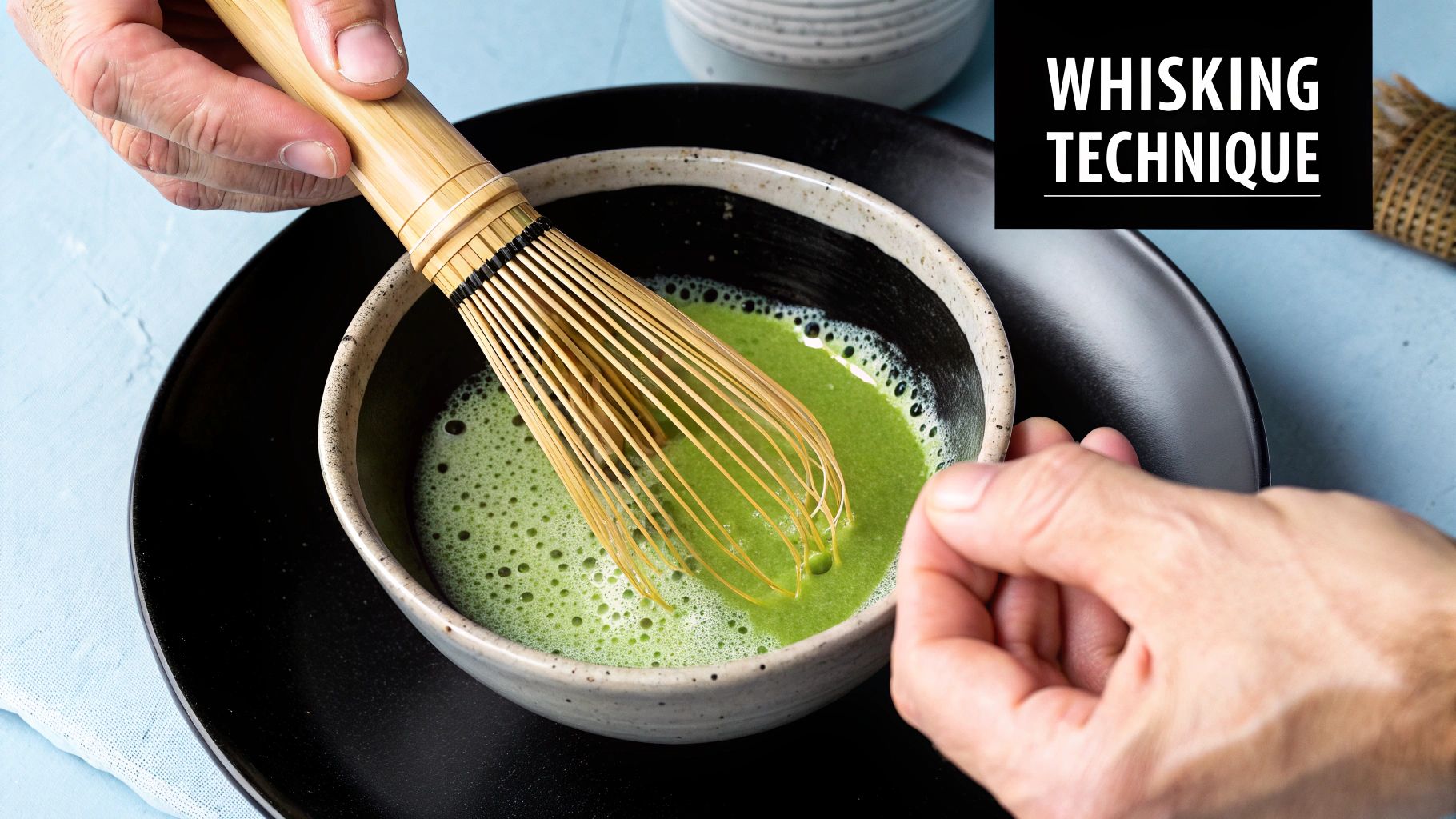
Now that you’ve got the hang of how to whisk matcha, you’re ready to take your daily ritual to the next level. This is where the simple act of preparing tea becomes a truly meaningful practice, one that opens up a whole new world of flavour and functional wellness.
This is the perfect time to explore what our carefully crafted blends can bring to your day. Your newfound whisking technique is what allows you to fully unlock the unique character and benefits of each Amatsu Matcha formula.
Think of your whisking skill as the key and Amatsu Matcha as the door to a more intentional routine. Now, you can turn every cup into a targeted act of self-care.
Tailor Your Matcha to Your Day
With Amatsu Matcha, your daily bowl can be precisely aligned with what your body and mind need. Each blend is designed to be whisked just as you’ve learned, with only minor adjustments for their unique ingredients.
Here’s a glimpse of how you can elevate your practice:
- For Pure, Focused Energy: Begin with Amatsu Pure. This is our ceremonial grade matcha, perfect for the traditional whisking method you've just mastered. It delivers clean, sustained energy and a moment of pure calm.
- For Enhanced Focus: Need more mental clarity? Whisk up Amatsu Shrooms. This blend adds the power of Lion’s Mane and Cordyceps mushrooms, fully integrated for a smooth, earthy brew.
- For Workout Support: Preparing for a gym session? A bowl of Amatsu Strength provides a pre-workout boost with creatine, supporting your performance and endurance.
- For Inner Radiance: Support your skin's health from within by whisking a bowl of Amatsu Radiance. Infused with marine collagen, this blend dissolves perfectly to create a nourishing, creamy drink.
You’re joining a growing movement. The UK matcha tea market is projected to be worth over USD 517 million by 2035, largely because people are seeking out functional drinks just like these.
By applying your skills to these blends, you're not just making tea; you're creating a personalised wellness experience. Find out what sets us apart by reading our guide on why Amatsu is the best matcha in the UK.
Your Matcha Whisking Questions, Answered
Getting the whisking technique down is a huge step, but a few questions always pop up as you start to make matcha part of your routine. Let's walk through some of the most common ones I hear, so you can feel completely confident every time you prepare a bowl.
Can I Just Use a Milk Frother Instead of a Bamboo Whisk?
You can technically mix the powder with an electric milk frother, but it's a bit like using a sledgehammer to crack a nut. It just won't give you that authentic, creamy texture you're looking for.
A proper bamboo whisk, or chasen, is a masterpiece of design. Its 80-120 flexible tines are engineered to suspend the fine tea particles evenly in the water while whipping up a delicate, stable microfoam. Electric frothers, on the other hand, are too aggressive. They create big, soapy bubbles that disappear almost immediately, leaving you with a thin, watery brew instead of that velvety mouthfeel.
What’s the Perfect Water Temperature for Matcha?
This is a big one. The ideal temperature for whisking matcha is between 70–80°C. It's a common mistake to use boiling water straight from the kettle, but this high heat will literally scorch the delicate powder. The result? A harsh, unpleasantly bitter flavour that masks all the tea's subtle sweetness.
Don't have a variable-temperature kettle? No problem. Just boil your water, then let it sit with the lid off for about 3–5 minutes. This will cool it down to the perfect range for a beautifully balanced cup.
How Do I Clean and Look After My Bamboo Whisk?
Looking after your chasen is simpler than you might think, and it makes all the difference in how long it lasts. Once you're done, just rinse it thoroughly under warm running water. The most important rule is to never, ever use soap. It can easily get trapped between the delicate tines and will ruin the flavour of your next bowl of matcha.
After rinsing, gently shake off the excess water and place it on a whisk holder (a kusenaoshi). This little ceramic stand is essential—it helps the whisk air dry properly and maintain its elegant, open shape, preventing the tines from becoming brittle and breaking. Whatever you do, don't put it in the dishwasher or store it away while it’s still damp.
Is Sifting the Matcha Powder Really Necessary?
Yes, absolutely. This is one of those small steps that has a huge impact on the final result. Matcha is an incredibly fine powder, and because of static and humidity, it clumps together very easily.
Pushing it through a fine-mesh sieve is the only way to guarantee you break up all those tiny lumps. This simple action ensures your matcha whisks into a perfectly smooth, silky liquid, with no disappointing gritty bits at the bottom of your bowl.
Ready to put your whisking skills to the test with some truly exceptional matcha? Explore the Amatsu Matcha collection and discover functional blends designed to elevate your daily ritual.
Read more
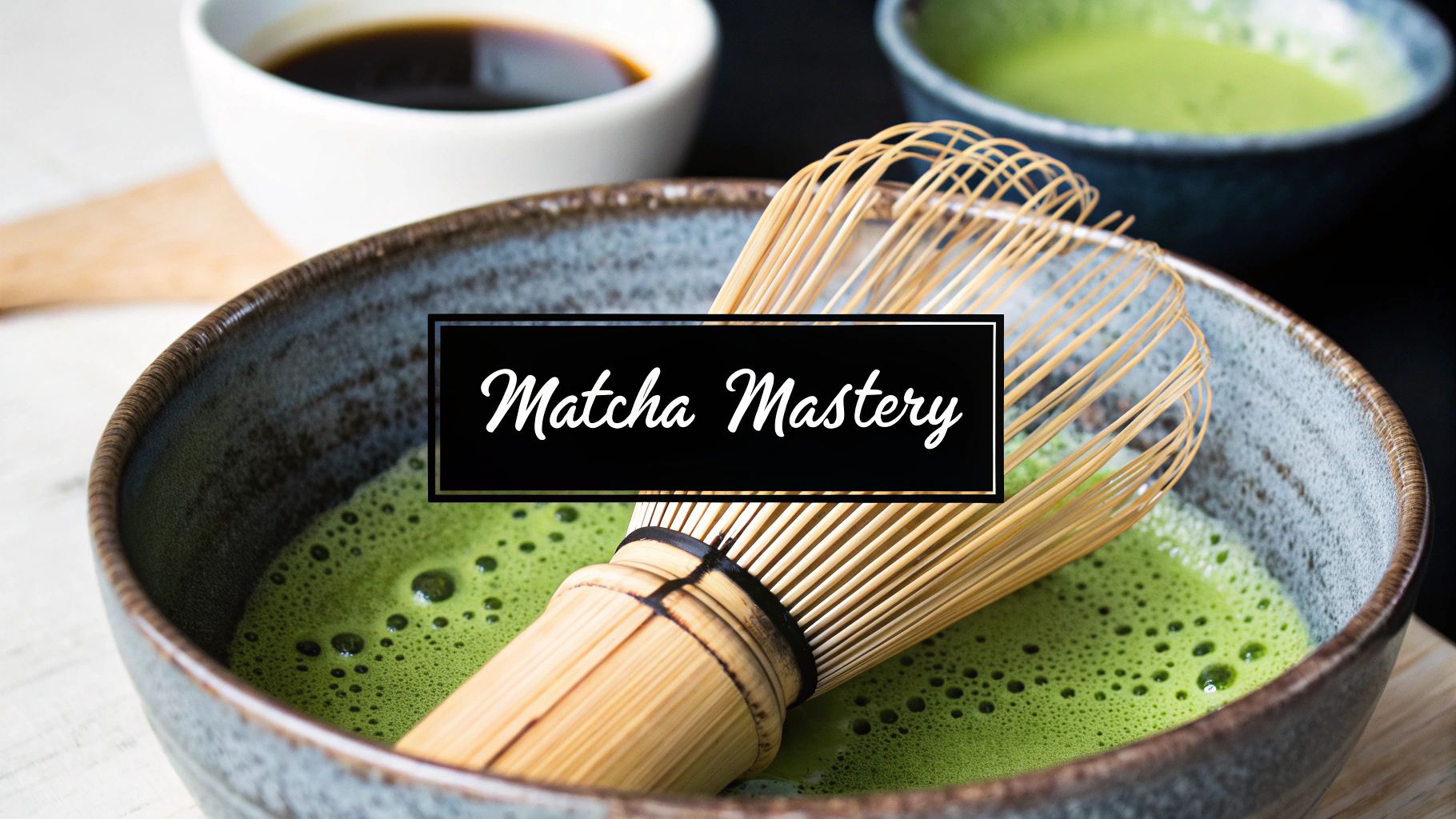
Learn how to use matcha powder to make perfect drinks and more. Our guide offers practical tips for lattes, traditional tea, and creative recipes.
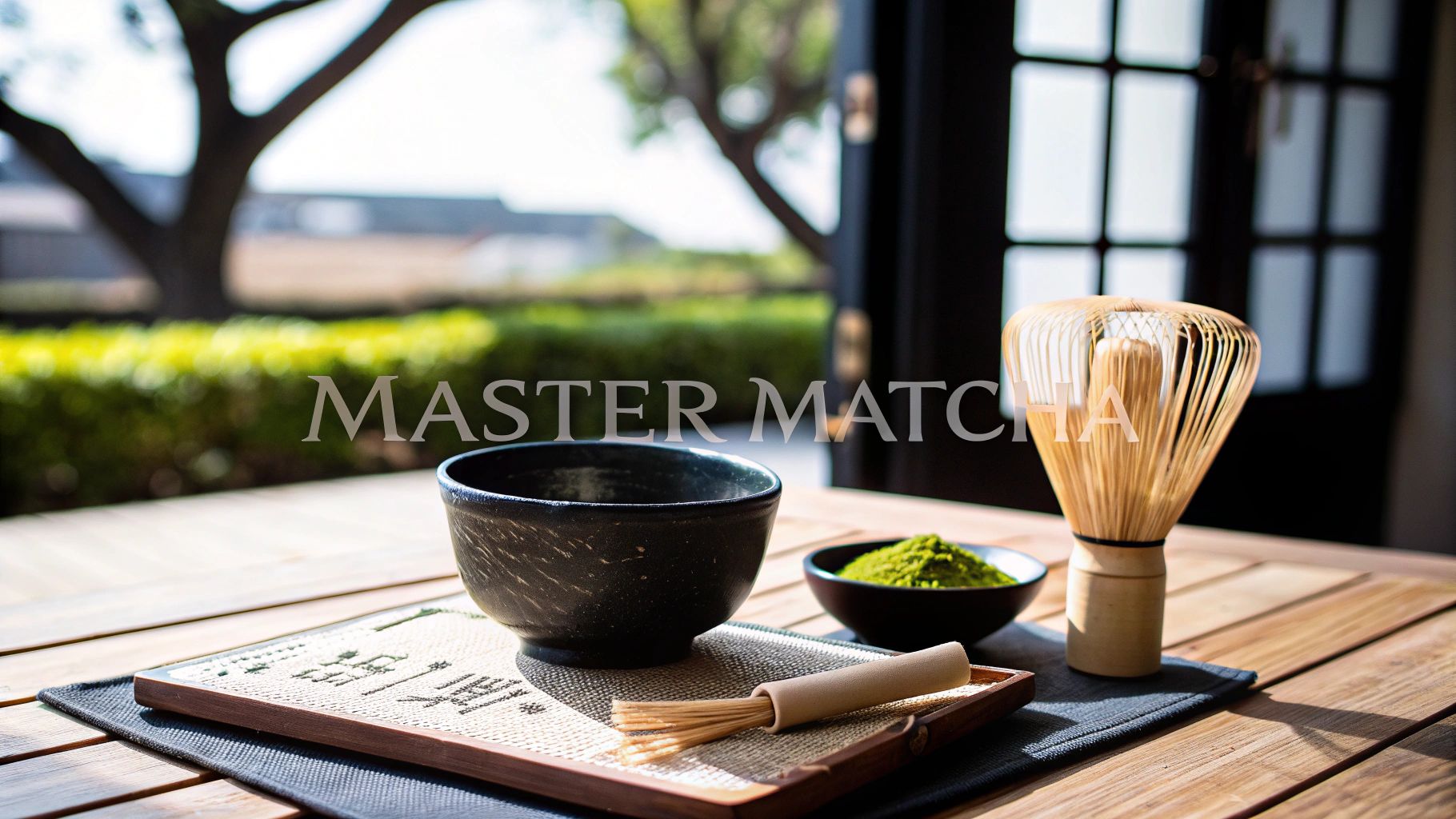
Learn how to prepare matcha tea at home with our authentic guide. Discover the right tools, whisking techniques, and recipes for a perfect cup of Amatsu Matcha.
